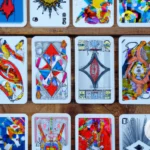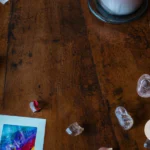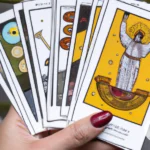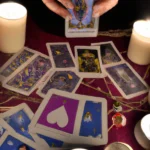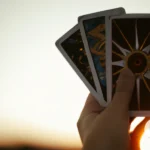Tarot card readings can be a valuable tool for gaining insight and guidance in various areas of life. One of the most popular spreads used in tarot readings is the Past-Present-Future Spread. This spread provides a holistic view of a situation by examining the past events that led to the present circumstances, and the potential outcomes in the future. However, interpreting the cards in this spread can be challenging, especially for beginners. In this article, we will provide a comprehensive guide on how to interpret the cards in the Past-Present-Future Spread, step by step. By the end of this article, you will have a better understanding of how to use this spread to gain valuable insight into your life or the lives of those around you.
Understanding the Past-Present-Future Spread
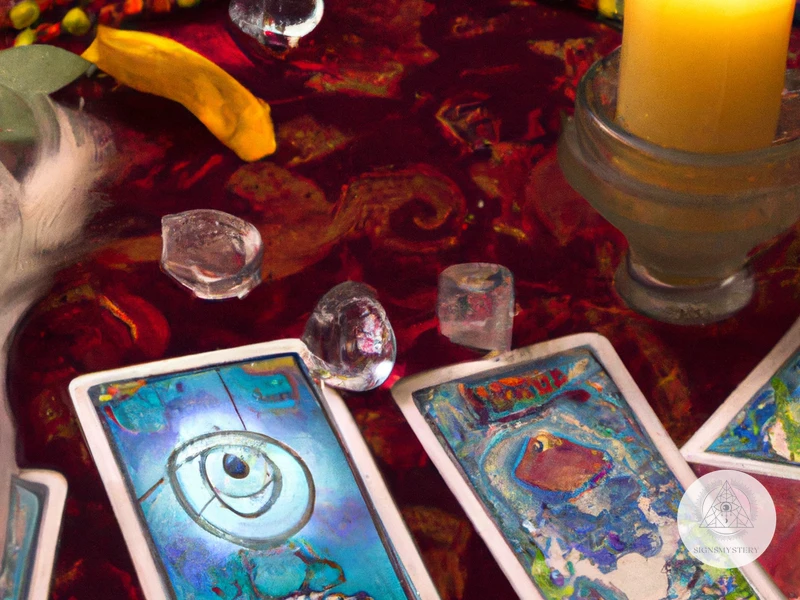
When it comes to tarot readings, there are many different spreads to choose from. Each spread has its own unique focus and can provide insight into different areas of life. One of the most commonly used spreads is the Past-Present-Future Spread. This three-card spread can offer valuable insights into the past events that have led to the current situation, as well as what the future may hold. If you’re new to the Past-Present-Future Spread, you may have questions about how to interpret the cards, what the layout means, and how to prepare for the reading. In this section, we’ll dive into the specifics of this popular spread to help you better understand how it works, and what to expect from your reading.
What is the Past-Present-Future Spread?
The Past-Present-Future spread is a popular tarot card reading technique that provides insight into a person’s past, present, and future. It is a 3-card spread that is relatively easy to interpret and can be adapted to various situations. This spread is especially useful for those seeking clarity on a particular situation in their lives and how it relates to their past and future.
How does it work?
The first card represents the past, the second card represents the present, and the third card represents the future. The cards are laid out in a straight line, with the past card on the left, the present in the middle, and the future on the right. Each card provides insight into the corresponding time period and collectively, they tell a story.
The Past-Present-Future spread is a popular technique for both beginners and experienced readers because it is straightforward and provides clear answers. It allows the reader to gain insight into how past actions or events have led up to the present, and what the future may hold.
Many tarot readers rely on this spread because it is versatile and can be applied to various situations. It can be used to gain insight into relationships, career decisions, personal growth, or any other area of a person’s life.
Benefits of the Past-Present-Future Spread
The Past-Present-Future spread provides several benefits. First, it is simple and easy to interpret. Second, it provides insight into a person’s past and how it relates to their present and future. Third, it can be applied to various situations and can help individuals gain clarity on difficult decisions. Lastly, it is a useful tool for personal reflection and growth.
If you want to know more about the types of cards in this spread or how to interpret them, continue reading our article about the Past-Present-Future Spread here. Additionally, if you are interested in learning about more tarot reading techniques and tips, check out our 5 Tips for Successful Tarot Reading article.
How to Prepare and Shuffle the Deck
To begin a Past-Present-Future spread, it’s important to first prepare and shuffle the deck properly to ensure that the cards are clear and unbiased. Here are some steps to follow:
1. Choose and Clear your Tarot Deck: Select a tarot deck that resonates with you and that you feel comfortable using. Take a moment to clear any negative or stale energy from the deck by either smudging it with sage or palo santo or tapping it gently against a hard surface.
2. Focus Your Energy: Take a few deep breaths and focus your attention on the task at hand. This is a time to put aside any distractions and concentrate on your intuition.
3. Shuffle the Deck: There are several ways to shuffle the deck, but the most common method is to hold the deck in your hands and shuffle the cards while focusing on the question or issue you want to explore.
4. Know When to Stop Shuffling: When you feel that the deck has been sufficiently shuffled, stop and take a moment to connect with the energy of the deck.
5. Re-Order the Deck: Before laying out the cards, it’s important to re-order the deck so that it is in the right order for the Past-Present-Future spread. If you’re using a traditional Tarot deck, make sure that the Major Arcana cards are separated from the Minor Arcana cards.
6. Select the Cards: When you’re ready to lay out the cards, hold the deck in your hands and ask your question or focus your energy on the issue you want to explore. Then, select three cards and place them in the Past-Present-Future positions.
Remember, the process of shuffling and preparing the deck is an important part of the Tarot reading process. These steps help to focus your energy and intention, and create a clear and unbiased reading. If you’re struggling with shuffling or any other aspects of Tarot reading, check out our guide on overcoming common difficulties in Tarot spreads. And if you’re interested in exploring other Tarot spreads, take a look at our guide to Past-Present-Future spread variations.
How to Lay Out the Cards
To properly perform the Past-Present-Future Spread, it’s important to know how to lay out the cards. The layout is simple and easy to follow, but it’s important to pay attention to the placement of each card.
Here’s how to lay out the cards in the Past-Present-Future Spread:
| Card 1 | Card 2 | Card 3 |
| The Past | The Present | The Future |
Card 1 is placed on the left side of the layout, representing the past. Card 2 is placed in the middle, representing the present. And Card 3 is placed on the right side, representing the future.
It’s important to remember that the placement of the cards is significant, and the interpretation of each card will be based on its position in the layout. Take a moment to focus on the question or situation you’re seeking guidance on before laying out the cards. This will help you to stay focused and tune in to the energies of the cards.
Once you’ve shuffled the deck and have your question in mind, lay the cards out in the designated positions. Make sure each card is facing up so you can see the image and any symbols or numbers displayed. You’re now ready to begin interpreting the meaning of each card.
Interpreting the Cards
As the cards are laid out in front of you, you may find yourself feeling overwhelmed with the task of interpreting their meanings. However, with practice and a willingness to trust your instincts, interpreting the cards in a Past-Present-Future Spread can be a deeply rewarding experience. In this section, we will explore each card in the spread and provide guidance on how to interpret their meanings in the context of your unique situation. So, let’s dive in and begin uncovering the insights and guidance that the cards have to offer.
Card 1: The Past
When interpreting the first card in the Past-Present-Future spread, it’s important to remember that it represents the past events or influences that have led up to the present situation. Here are some steps to follow when interpreting Card 1:
- Take note of the image: Look closely at the image on the card and see what it suggests to you. Is the image clear or murky? Light or dark? What symbols or objects stand out to you?
- Consider the card’s meaning: Each tarot card has its own unique meaning, so it’s important to understand what the card represents. For example, the Ace of Cups could indicate a new relationship or emotional beginning, while the Five of Swords could suggest conflict or betrayal.
- Relate the card to the question: Think about how the card’s meaning and image relate to the specific question being asked. If the question is about a relationship, does the card suggest past issues or challenges in that area?
- Look for connections: Consider how Card 1 relates to the other cards in the spread. Are there any similarities or connections between them that could provide further insight?
Remember, the interpretation of Card 1 is not set in stone, and can vary depending on the individual reader and the specific context of the reading. Trust your intuition and use the card as a starting point for exploring the past influences on the present situation.
Card 2: The Present
In the Past-Present-Future spread, the second card represents the present moment. This card can offer insight into the current state of things, including any challenges or opportunities that may be present.
The Meaning of the Present Card
When interpreting the present card, consider its meaning in relation to the past and future cards. How does it connect or contrast with those cards? Does it offer a solution or a warning?
Some possible interpretations of the present card are:
- The card may represent a current challenge or obstacle that needs to be addressed.
- It may indicate a stage of transition or change.
- The card can offer insight into the current state of relationships, work, or personal life.
- The present card may highlight opportunities that are currently available or that will soon present themselves.
- It may offer guidance for navigating the present moment with clarity and purpose.
Example Interpretation:
For example, if the past card is the Three of Swords, indicating heartbreak or emotional pain, and the future card is the Seven of Swords, which can represent deception or hidden motives, then the present card may be the Six of Cups. In this case, the present card may indicate a period of healing and emotional restoration. This card can also suggest that revisiting past relationships or memories may be important for the present moment.
| Past Card: Three of Swords | Present Card: Six of Cups | Future Card: Seven of Swords |
|---|---|---|
| Heartbreak, emotional pain | Healing, restoration, revisiting past | Deception, hidden motives |
As with all cards, the interpretation will depend on the individual circumstances and the reader’s intuition. Trust your instincts and consider the card in relation to the other cards in the spread to gain a deeper understanding of the present moment.
Card 3: The Future
When interpreting Card 3, focus on potential outcomes and what actions or decisions need to be made to achieve the desired result. Here is a sample table to help guide your interpretation:
| Aspect | Meaning | Questions to Consider |
|---|---|---|
| General Meaning | The outcome or potential future based on current circumstances. | What is the likely outcome based on the past and present? What challenges or opportunities may arise? |
| Love/Relationships | The potential outcome of the current relationship or future relationships. | What can be done to strengthen the current relationship? What potential challenges or opportunities may arise in future relationships? |
| Career/Finances | The potential outcome of career or financial decisions. | What actions need to be taken to achieve desired career or financial goals? What obstacles or opportunities may arise? |
| Health/Wellness | The potential outcome of health and wellness decisions or conditions. | What actions need to be taken to improve overall health and wellness? What potential obstacles or opportunities may arise? |
Remember to consider the surrounding cards and any clarifying cards to gain a deeper understanding of the potential outcome. Also, keep in mind that the future is not set in stone and can be influenced by current actions and decisions.
Card Combinations and Clarifiers
When interpreting a three-card spread, it’s essential to understand how the cards relate to one another. An effective way to gain deeper insight into the reading is to examine the possible card combinations and clarifiers. Here’s what you need to know:
| Card Combination | Meaning |
|---|---|
| Two or Three Major Arcana Cards | This indicates a powerful and significant turning point in the past, present, or future. |
| Major Arcana and Minor Arcana Card | The Major Arcana card holds more weight and should be given more attention in the reading. |
| Two or Three Court Cards | This may suggest a situation heavily influenced by individuals who hold positions of power or authority in the past, present, or future. |
| Two or Three Cards of the Same Suit | This indicates a situation strongly influenced by the qualities represented by that specific suit. |
| Repeating Numbers or Symbols | These show a strong emphasis on the meaning and message of these specific cards and should be given extra attention in the reading. |
Clarifiers, often referred to as “helper” or “supporting” cards, can also provide further insight into the three main cards in the spread. A clarifier is often drawn from the shuffled deck after the original spread is laid out, and it’s a useful tool for gaining more information about specific aspects of the reading.
When interpreting clarifiers, be sure to pay attention to the relationship between the clarifier and the main card. Here are some guidelines to follow:
| Clarifier Placement | Meaning |
|---|---|
| Before the “Past” Card | Provides insight into past experiences, how they have influenced the current situation, or what needs to be addressed to move forward. |
| Between the “Past” and “Present” Cards | Indicates a link or transition between past and present experiences or reveals what needs to be addressed before moving on to the present. |
| Before the “Future” Card | Provides insight into what needs to happen or what to focus on to make the most of future opportunities. |
| After the “Future” Card | Indicates what may be a potential outcome in the future or what to avoid. |
By paying attention to card combinations and clarifiers, you can glean a wealth of information from a simple three-card spread. These tools take your reading to the next level and allow you to provide more in-depth and nuanced interpretations for yourself or your clients.
Reversed Cards
When interpreting tarot cards, it’s important to pay attention to whether a card appears upright or reversed. A reversed card can alter the meaning of the card, adding a different perspective or obstacle to the interpretation.
So, what does it mean when a card appears reversed?
Traditionally, reversed cards can represent the opposite or a lack of the card’s normal meaning. For example, the upright Ace of Cups represents new beginnings and emotional fulfillment, but when reversed, it could indicate blocked emotions or a lack of creativity in expressing emotions. However, it’s important to note that reversed cards can also indicate the need for introspection and personal growth.
To better understand the meaning of a reversed card, you can refer to the upright meanings and look for themes of difficulty, stagnation, or blocked energy. You can also consider the position of the card in the spread, as a reversed card in the “present” position could indicate a current challenge or obstacle.
How to interpret reversed cards in a Past-Present-Future spread:
| Card Position | Upright Interpretation | Reversed Interpretation |
|---|---|---|
| Past | A reflection of past experiences or influences | The lingering effects of past experiences or unresolved issues |
| Present | A current situation or challenge | An obstacle or blockage in the present |
| Future | Potential possibilities or outcomes | The need for introspection or personal growth before reaching the desired outcome |
It’s important to remember that a reversed card does not always have a negative connotation. It can simply add a layer of complexity or nuance to the reading. When interpreting reversed cards, always approach the interpretation with an open mind and consider the context and overall energy of the spread.
Tips and Advice
As you embark on your journey of interpreting the cards in a Past-Present-Future spread, there are some essential tips and advice to keep in mind. These guidelines will help you delve deeper into the meanings behind each card and gain a better understanding of the overall message the spread is trying to convey. While there is no one definitive way to interpret tarot cards, incorporating these suggestions can enhance your tarot reading experience and provide greater insight into the past, present, and future.
Trust Your Intuition
One of the most important things you can do when interpreting the cards in a Past-Present-Future Spread is to trust your intuition. Intuition is a
Subscribe to Our Newsletter
Sign up to receive the latest news and updates.
When you are interpreting the cards, take a moment to really look at each card and pay attention to your first gut reaction. What thoughts come to mind when you first see the card? What feelings does it evoke?
It is important to remember that there is no right or wrong way to interpret a tarot card. Your interpretation may be different from someone else’s, and that is okay. Trust yourself and your intuition, and allow yourself to be guided by the messages that the cards are showing you.
If you find yourself struggling to understand the meaning of a card or feeling unsure about your interpretation, take a step back and meditate on the card. Close your eyes and visualize the card in your mind’s eye. Ask yourself what the card is trying to tell you, and be open to receiving any insights or messages that may come through.
Remember, the more you work with the tarot and trust your intuition, the stronger your connection to the cards will become. Over time, you will develop your own unique style of interpreting the cards and will feel more confident in your ability to access your inner wisdom and intuition.
Consider the Whole Picture
When interpreting the cards in a Past-Present-Future spread, it’s important to consider the whole picture that the cards are painting. This means taking into account not only the meanings of individual cards but also how they relate to each other and the overall narrative they create.
One technique to help with this process is to use an interpreting table. This table can be created by drawing a simple grid on a piece of paper or by using a spreadsheet software like Excel.
In the grid, list each card in the Past-Present-Future spread in the left-hand column, and then use the top row to identify important themes or keywords that were present in the reading. Some examples of themes could be “love,” “career,” “family,” or “spirituality.”
Then, use the remaining cells to consider how each card relates to each theme. For example, if the first card represents the past and the theme is “love,” you might reflect on how past experiences or relationships have influenced the querent’s current understanding of love. Similarly, if the third card represents the future and the theme is “career,” you might consider what opportunities or challenges the querent may face in their professional life moving forward.
By using this table, you can begin to see patterns and connections between the cards that may not be immediately obvious. You can also use it as a tool to help identify potential courses of action or areas where the querent may need to focus their attention in order to achieve their desired outcome.
Of course, this is only one approach and there may be other methods that work better for you. The key is to remain open-minded and willing to explore different possibilities until you find a system that works best for your unique style and preferences. By considering the whole picture and using tools like an interpreting table, you’ll be better equipped to provide accurate, insightful readings that help your clients navigate life’s ups and downs with greater clarity and confidence.
Take Notes and Reflect
One of the most important steps to take after interpreting the cards in a Past-Present-Future Spread is to take notes and reflect on what you’ve learned. This not only helps to solidify your interpretation, but it can also provide guidance for future readings and decisions.
Taking Notes
When taking notes, it’s important to record not only the cards that were drawn, but also your initial thoughts and impressions. Did any specific details or symbols stand out to you? Did you have a strong emotional reaction to any of the cards? Write down any insights or revelations that came to mind during the reading.
You may also want to keep track of any card combinations or clarifiers that were used, as well as any reversed cards and their corresponding meanings. This can be especially helpful if you plan on revisiting the reading later on.
Reflecting on the Reading
Once you’ve taken notes, take some time to reflect on what you’ve learned from the reading. Think about how the cards relate to your current situation or question, and consider any advice or warnings that the cards may be giving you.
If the reading provided a clear answer or direction, think about what steps you can take to put that guidance into action. If the reading was more ambiguous, reflect on the various possibilities and what they could mean for your future.
Using Your Notes
Your notes can be a valuable tool for future readings and personal growth. Reviewing your notes from past readings can help you track patterns and progress over time, and can also provide insight into any recurring themes or challenges in your life.
You may also want to refer to your notes before making important decisions or taking actions related to the reading. This can help you stay focused on your goals and make the most informed choices possible.
Taking notes and reflecting on the cards in a Past-Present-Future Spread can be a powerful way to gain insight and guidance from the tarot. With practice and patience, this process can become an integral part of your spiritual and personal development.
| Taking Notes | Reflecting on the Reading | Using Your Notes |
|---|---|---|
| Record cards drawn and initial thoughts and impressions | Consider how the cards relate to the question or situation | Review notes for patterns and progress over time |
| Document card combinations and reversed cards | Reflect on advice or warnings provided by the cards | Refer to notes before making important decisions or taking actions |
| Write down insights or revelations from the reading | Think about possibilities and what they could mean for the future | Use notes to stay focused on goals and make informed choices |
Conclusion
As we come to the end of our journey through the mystical world of tarot card reading, it’s normal to feel a sense of confusion and uncertainty. The art of interpreting the cards in a past-present-future spread is a complex and nuanced process that requires patience, practice, and a deep understanding of the symbolism and meanings behind each card. Throughout this article, we’ve covered the basics of preparing and laying out the cards, as well as delving into the interpretation of each card in relation to its temporal context. But despite our efforts to demystify this ancient art, there may still be questions lingering in your mind as you step forward into the unknown.
Final Thoughts
After performing a Past-Present-Future spread, it’s important to reflect on the readings to gain insight and understanding from the cards. Here are some final thoughts to keep in mind:
| Don’t Take the Cards’ Meanings as Gospel |
| While the Tarot can offer guidance and insight, it’s essential to remember that the cards’ meanings are not set in stone. The interpretation of the cards is subjective and can be influenced by various factors, such as the reader’s intuition and the querent’s personal circumstances. |
| Use the Spread as a Tool for Self-Reflection |
| When interpreting a Past-Present-Future spread, consider the cards as a mirror reflecting different aspects of your life. Use the insights gained to reflect on your past actions, change your present behavior, and plan for the future. |
| Keep an Open Mind |
| It’s easy to fall into the trap of interpreting the cards solely based on preconceived notions or biases. Instead, approach the reading with an open mind, and try to view the cards as objectively as possible. |
| Trust Yourself |
| While it’s useful to seek guidance from others, ultimately, trust yourself when interpreting the cards. You know yourself and your situation better than anyone else, and your intuition can provide valuable insights that might be overlooked by others. |
By following the steps outlined in this article and keeping these tips and final thoughts in mind, a Past-Present-Future Tarot spread can be a powerful tool for gaining insight, self-reflection, and personal growth. Remember to approach the reading with an open mind, trust your intuition, and consider the cards’ meanings as subjective rather than absolute.
Frequently Asked Questions
How accurate are Past-Present-Future tarot readings?
The accuracy of the tarot readings depends on the skill of the tarot reader and the level of intuition. As long as you find a trustworthy tarot reader, the Past-Present-Future Spread can provide valuable insights into your life.
Can the Past-Present-Future tarot reading predict the future?
The tarot reading is not meant to predict the future with certainty, but rather to inform you of potential outcomes based on your current circumstances.
How long does a Past-Present-Future tarot reading take?
The length of a tarot reading can vary depending on the individual reader and the number of cards used in the spread. However, most tarot readings take around 30 minutes to complete.
What if I don’t like the outcome of the Past-Present-Future tarot reading?
The tarot reading is not set in stone, and you have the power to change your future based on the insights gained from the reading. If you don’t like the outcome, you can make changes to your current circumstances to change the future.
How often should I get a Past-Present-Future tarot reading?
It is recommended to get a tarot reading every three to six months to gain insights into your current circumstances and potential future outcomes.
Can I ask yes or no questions during a Past-Present-Future tarot reading?
Yes, you can ask yes or no questions during a tarot reading. However, remember that the tarot reading is not a magic 8-ball, and the answers may not be as straightforward as a simple yes or no.
Can anyone learn to read tarot cards?
Yes, anyone can learn to read tarot cards with the right resources and a willingness to learn. It takes time, practice, and intuition to become proficient in tarot reading.
Can I perform a Past-Present-Future tarot reading for someone else?
Yes, you can perform a tarot reading for someone else. However, it is important to obtain their consent and to approach the reading with respect and empathy.
Should I ask specific or open-ended questions during a Past-Present-Future tarot reading?
It is recommended to ask open-ended questions during a tarot reading to provide a more detailed and insightful response. Specific questions may limit the scope of the reading and may not provide comprehensive insights.
Can a Past-Present-Future tarot reading replace professional advice?
No, a tarot reading cannot replace professional advice from a licensed therapist, doctor, or financial advisor. However, it can provide additional insights and perspectives that can complement professional advice.



